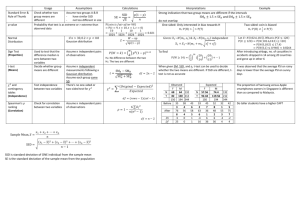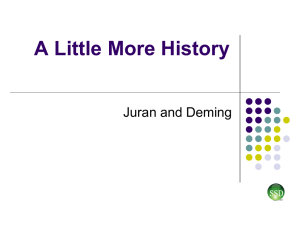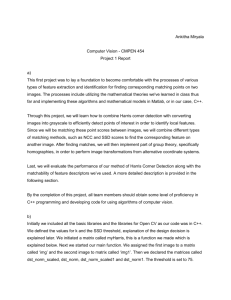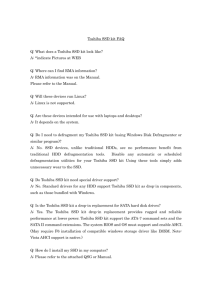Word
advertisement
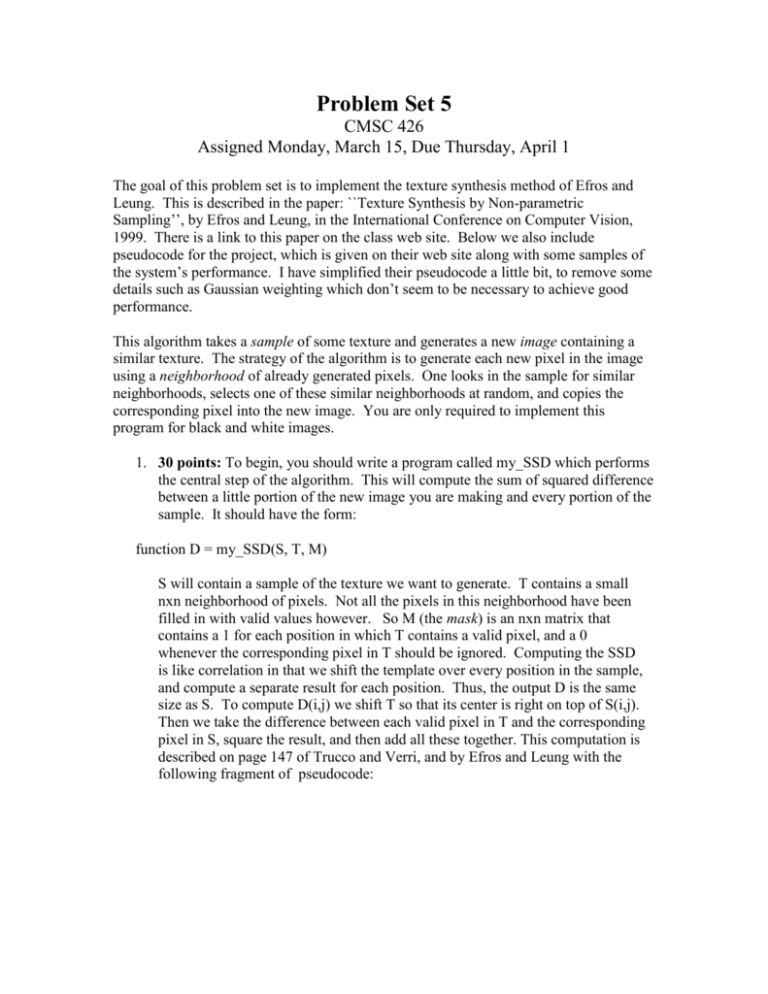
Problem Set 5 CMSC 426 Assigned Monday, March 15, Due Thursday, April 1 The goal of this problem set is to implement the texture synthesis method of Efros and Leung. This is described in the paper: ``Texture Synthesis by Non-parametric Sampling’’, by Efros and Leung, in the International Conference on Computer Vision, 1999. There is a link to this paper on the class web site. Below we also include pseudocode for the project, which is given on their web site along with some samples of the system’s performance. I have simplified their pseudocode a little bit, to remove some details such as Gaussian weighting which don’t seem to be necessary to achieve good performance. This algorithm takes a sample of some texture and generates a new image containing a similar texture. The strategy of the algorithm is to generate each new pixel in the image using a neighborhood of already generated pixels. One looks in the sample for similar neighborhoods, selects one of these similar neighborhoods at random, and copies the corresponding pixel into the new image. You are only required to implement this program for black and white images. 1. 30 points: To begin, you should write a program called my_SSD which performs the central step of the algorithm. This will compute the sum of squared difference between a little portion of the new image you are making and every portion of the sample. It should have the form: function D = my_SSD(S, T, M) S will contain a sample of the texture we want to generate. T contains a small nxn neighborhood of pixels. Not all the pixels in this neighborhood have been filled in with valid values however. So M (the mask) is an nxn matrix that contains a 1 for each position in which T contains a valid pixel, and a 0 whenever the corresponding pixel in T should be ignored. Computing the SSD is like correlation in that we shift the template over every position in the sample, and compute a separate result for each position. Thus, the output D is the same size as S. To compute D(i,j) we shift T so that its center is right on top of S(i,j). Then we take the difference between each valid pixel in T and the corresponding pixel in S, square the result, and then add all these together. This computation is described on page 147 of Trucco and Verri, and by Efros and Leung with the following fragment of pseudocode: for i,j do for ii,jj do dist = (Template(ii,jj)-SampleImage(i-ii,j-jj))^2 SSD(i,j) = SSD(i,j) + dist*ValidMask(ii,jj) end SSD(i,j) = SSD(i,j) / TotWeight End However, in Matlab, it will be more efficient to implement this without looping. Here are some hints on how to do this. First, notice that (T(ii,jj)-S(i-ii,j-jj))^2 = T(ii,jj)^2 – 2*T(ii,jj)*S(i-ii,j-jj) + S(i-ii,j-jj)^2. Notice also that we can compute: for i,j do for ii,jj do dist = Template(ii,jj)*SampleImage(i-ii,j-jj); COR(i,j) = COR(i,j) + dist*ValidMask(ii,jj) end end with one call to imfilter with SampleImage and (Template.*ValidMask) as arguments. The other parts of SSD can also be computed without any explicit looping. We can compute: for i,j do for ii,jj do dist = SampleImage(i-ii,j-jj)^2; COR(i,j) = COR(i,j) + dist*ValidMask(ii,jj) end end by calling imfilter with SampleImage.^2 and ValidMask as arguments. Test your function using the checkerboard function that we provide. Execute the call: my_SSD(checkerboard(3,3),[0 1 1; 1 0 -1; 1 0 0], [1 1 1; 1 1 0; 1 1 1]) and turn in a printout of the results, along with your code. 2. 20 points: Using my_SSD and the pseudocode below, implement the function FindMatches. This should find all candidate pixels in the sample that have a neighborhood that is sufficiently similar to the template. In finding the best matches it is also important that you not loop through the entire image. You may find the Matlab function ‘find’ useful. You might want to write FindMatches so that it takes three inputs: the sample image, the template, and the mask. Test your program on the same example that you used in problem 1. Hand in printouts of the results, and of your program. 3. 40 points: Now complete your program, following the pseudocode below. Test your program using the checkerboard function to generate a sample checkerboard pattern, and using the bricks image. Hand in printouts of the results. Be warned that with this algorithm it can be a bit slow to generate a large texture, even if you have implemented my_SSD efficiently. My implementation takes several minutes to generate a 100x100 image on my laptop. 4. 10 points: Use two more images of your own choosing as sample textures and generate new textures using these samples. Turn in printouts of the original images and of the textures you generate. Also, include these images in your electronic submission. For 5 points extra credit, modify your program so that it will work with color images, and generate color textures. 5. Challenge Problem 15 points: Implement Gaussian smoothing described in the paper. Then identify an image for which this algorithm fails, for any choice of parameters. Demonstrate this with some examples. Suggest possible ways of improving the algorithm to handle this image. Appendix: Below is pseudocode provided by Efros and Leung. Please note that when you code this project in Matlab you won’t want to follow this pseudocode exactly. For example, some operations that they perform with loops, you will want to perform with single Matlab routines. Algorithm details Let SampleImage contain the image we are sampling from and let Image be the mostly empty image that we want to fill in (if synthesizing from scratch, it should contain a 3by-3 seed in the center randomly taken from SampleImage, for constrained synthesis it should contain all the known pixels). WindowSize, the size of the neighborhood window, is the only user-settable parameter. The main portion of the algorithm is presented below. I have removed the part of the pseudocode that deals with Gaussian filtering, for simplicity. function GrowImage(SampleImage,Image,WindowSize) while Image not filled do progress = 0 PixelList = GetUnfilledNeighbors(Image) foreach Pixel in PixelList do Template = GetNeighborhoodWindow(Pixel) BestMatches = FindMatches(Template, SampleImage) BestMatch = RandomPick(BestMatches) Pixel.value = BestMatch.value end return Image end Function GetUnfilledNeighbors() returns a list of all unfilled pixels that have filled pixels as their neighbors (the image is subtracted from its morphological dilation). The list is randomly permuted and then sorted by decreasing number of filled neighbor pixels. GetNeigborhoodWindow() returns a window of size WindowSize around a given pixel. RandomPick() picks an element randomly from the list. FindMatches() is as follows: function FindMatches(Template,SampleImage) ValidMask = 1s where Template is filled, 0s otherwise TotWeight = sum i,j ValidMask(i,j) for i,j do for ii,jj do dist = (Template(ii,jj)-SampleImage(i-ii,j-jj))^2 SSD(i,j) = SSD(i,j) + dist*ValidMask(ii,jj)*GaussMask(ii,jj) end SSD(i,j) = SSD(i,j) / TotWeight end PixelList = all pixels (i,j) where SSD(i,j) <= min(SSD)*(1+ErrThreshold) return PixelList end In our implementation the constant were set as follows: ErrThreshold = 0.1. Pixel values are in the range of 0 to 1.
